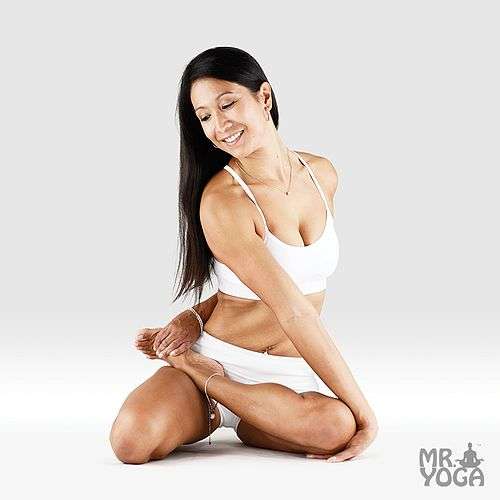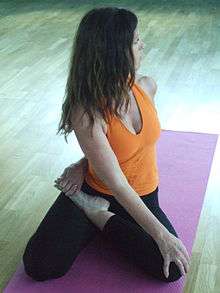Twisting Pose Dedicated to Bharadvaja - Bharadvajasana
|
Bharadvājāsana viewed from the front | |
| Etymology | |
|---|---|
| English name(s) | Bharadvaja's twist |
| Sanskrit | Sanskrit: भरद्वाजासन |
| Pronunciation | IPA: [bʱɐrɐd̪ʋɑːɟɑːsɐnɐ] |
| Meaning | asana dedicated to the sage Bharadvāja |
| Key Points | |
| dṛṣṭi (eye focus) | Pārśvadṛṣṭi dṛṣṭi (to the side) |
| Asana type | Sitting Asana |
| Iyengar difficulty |
|
| Effects summary | Relieves: Lumbago, Cervicalgia, and Sciatica. |
| Anatomy | |
| Muscles working |
Spine - twist side: Internal obliques, erector spinae, splenius capitis |
| Usage | |
| Location in Ashtanga Vinyasa series |
2nd series:
|

Bharadvajasana (IPA: [bʱɐrɐd̪ʋɑːɟɑːsɐnɐ]; Sanskrit: भरद्वाजासन; IAST: Bharadvājāsana) is an āsana.[1]
Etymology
The asana dedicated to sage Bharadvāja[2] who was one of the Saptarshis (Seven Great Sages Rishi) in the present Manvantara; the others being Atri, Vashishtha, Vishvamitra, Gautama, Jamadagni and Kashyapa.[3] Bharadvāja was also the father of Drona who was a master of advanced military arts and the royal guru to Kauravas, Pandavas and the Devastras.,[4] the princes who fought the great war which is the subject of the Mahābhārata.
Description

Bharadvājāsana is a basic seated spinal twist. It has three main variations:
- Bharadvājāsana II is the advanced variation requiring high hip mobility in which one leg articulated as in the Padmasana (lotus position), while the other leg is articulated as in the Vīrāsana.
- Bharadvājāsana I is the basic variation in which the legs articulated as in vīrāsana dropped to one side one foot on the floor and the other's ankle cradled in the arch of the foot below.
- Bharadvājāsana on chair is a third variant which is performed sitting sideways on an armless chair, which does not require hip mobility, utilizing the back seat to provide gentle resistance to the arms, to assist with the twist.
The vinyasa for Bharadvājāsana I begins in dandasana from which,
- The legs are bent at the knees, dropping them to the left, bringing the feet to the right hip.
- The right foot end top down on the floor and cradling the left ankle within the arch of the right foot.
- The torso is rotated 45° to the left.
- The right arm is straightened and the hand is inserted under the left knee.
- The legs are released, returning to dandasana for a few moments to release the knees.
- Repeat on the left side.
Anatomy

The main action in Bharadvājāsana is spinal rotation towards the leg which articulated as in the Vīrāsana
During a twist the torso is rotated right using the action of pair of muscles acting in synergy such as left external oblique and right internal oblique which work while the right external oblique and left internal oblique are stretched. Thus the ability to perform the twist depends both on the strength of the obliques and their ability to stretch, which can restrict the rotation.[5] If ujjayi breath technique is employed all the following muscles can be recruited for spinal twisting motion.
- Throughout the spine.
- The multifidus.[6]
- The rotatores.[6]
- The intertransversarii.[6]
- The erector spinae muscles[6] consisting of the longissimus, iliocastalis and Spinalis.
- The iliocastalis cervicis.[6]
- Rotation of the neck is due to rotation in the cervical spine using
- The left and right sternocleidomastoid[6] in the sides of the neck.
- The left and right spenius[6] in the back of the neck.
- The longus colli[6] in the back of the neck.
- The scalenes[6] in the back.
- The levator scapulae[6] in the back.
- Rotation of the torso is due to the thoracic and lumbar spine and using
- The inner and outer obliques.[6][5]
- The left and right psoas major.[6]
- The quadratus lumborum.[6]
In Bharadvājāsana, a typical practitioner should expect 5° of rotation in the lumbar spine (yellow); 35° in the thoracic spine (indigo) and 50° in the cervical spine (red).[7] These add up to 90° of spinal rotation between hips and head which may be reached in this twist. [8] However just trunk rotation has 26 articulation points and if any have a reduced range of motion the others will be forced to over-compensate which is the risk factor contributing to injury in yoga twists.[9]
Reduced mobility in the hips will necessitate some spinal flexion (leaning forward). In all but the tightest of hip this can usually be compensated by sitting on a supporting wedge which allows to a cleaner twisting motion without forward flextion. If a wedge cannot compensate then Bharadvājāsana, should be performed sitting on a chair.
Adjustments
To help ground the buttock on the side opposite the twist (e.g. when twisting right the left buttock may cause the spine to more out of alignment). The adjuster standing on the student's left side should place the left foot on the top of the student's left thigh with the inner edge of the foot in the hip crease and gently apply pressure. As the student exhales moving into the twist the top left thigh should relax away from the adjusting foot. The adjuster can reach and place fingers on both shoulders to help the student find the correct alignment of the shoulders through moving back and opening the chest.[10]
Cautions
For correct spinal alignment it is necessary that both buttocks be in contact with the floor. If the twisting causes one to tilt onto the buttock on the tilting side, a folded mat should be placed under the other buttock to allow one to relax with both buttocks on the floor.
If one slouches, the spine is not kept straight and the twist will be far less effective.
Benefits
- Stretches:
- Massages the abdominal organs.
- Improves digestion.
- Relieves:
- Lumbago,
- Cervicalgia, and
- Sciatica.
- Reduces stress.
- Useful for strengthening the lower back during second trimester of pregnancy.
- Therapeutic for carpal tunnel syndrome [11]
See also
- Ardha Matsyendrasana (Half Lord of the Fishes Pose) also known as "the seated twist"
- List of asanas
Notes
- ↑ Anonymous 2012.
- ↑ Iyengar 1979, p. 251—2.
- ↑ Inhabitants of the Worlds Mahanirvana Tantra, translated by Arthur Avalon, (Sir John Woodroffe), 1913, Introduction and Preface
- ↑ Hopkins 1915.
- 1 2 Gudmestad 2003.
- 1 2 3 4 5 6 7 8 9 10 11 12 13 Griffing 1999.
- ↑ Kapandji 1974.
- ↑ Coulter 2001, p. 397.
- ↑ Aaberg 2006, p. 23.
- ↑ thinkfirst 2012.
- ↑ Garfinkel et al. 1998.
References
- Aaberg, Everett (2006). Muscle Mechanics 2nd Edition. Leeds: Human Kinetics. p. 219. ISBN 0736061819. Retrieved 2012-12-10.
- Anonymous (2012). "Yoga Journal — Bharadvajasana". Retrieved 2012-12-10.
- Benitez, Denise. "For Beginners: Bharadvajasana I". Retrieved 2012-12-10.
- Budilovsky, Joan; Adamson, Eve (2000). The complete idiot's guide to yoga (2 ed.). Penguin. ISBN 978-0-02-863970-3.
- Cole, Roger (2004). "Yoga With Herniated Disk". Yoga Journal Injuries. Retrieved 2012-05-12.
- Coulter, H. David (2001). Anatomy of Hatha Yoga. Body and Breath Inc. ISBN 978-0-9707006-0-5.
- Fitz-Simon, Witold (2010). "Yoga Art and Science". Retrieved 2012-04-02.
- Garfinkel, Marian S.; Singhal, Atul; Katz, Warren A.; Allan; David A.; Reshetar, Rosemary; Schumacher, Ralph; Gallo, A. (1998). "Yoga-based intervention for carpal tunnel syndrome: A randomized trial". JAMA: The Journal of the American Medical Association. 280 (18): 1601–1603. doi:10.1001/jama.280.18.1601.
- Gudmestad, Julie (Jan–Feb 2003). "Anatomy of a Yogi - Let's twist again". Yoga Journal: 147–152.
- Guthrie, Catherine (2012). "Wear and Care". Retrieved 2012-12-10.
- Griffing, James (1999). "Spine Articulations". Retrieved December 12, 2012.
- Hopkins, Edward Washburn (1915). Epic Mythology. NY NY: Noble Offset Printers, Inc. ISBN 0819602280.
- Iyengar, B. K. S (1979). Light on Yoga. New York: Schocken. p. 62. ISBN 0-8052-1031-8.
- Kaminoff, Leslie; Matthews, Amy (2007). Yoga Anatomy. The Breath Trust. p. 221. ISBN 978-0-7360-6278-7.
- Kapandji, Ibrahim Adalbert (1974). The Physiology of the Joints. Vol III: The Trunk and the Vertebral Column. Churchill Livingstone. ISBN 0443012091.
- Long, Ray; Macivor, Chris (2009). The Key Muscles of Yoga. Bandha Yoga. ISBN 1607432382.
- Long, Ray; Macivor, Chris (2009). The Key Poses of Yoga. Bandha Yoga. ISBN 1607432390.
- Ranjini, V.V.; Paranjape, Kiran; Ramapriyan, H. K.; Gaurav; Las; Glashoff, K.; Mohan, Sam; Gallo, A. (2012). "SpokenSanskrit Dictionary". Retrieved 2012-12-10.
- Sinha, S. C. (1996). Dictionary of Philosophy. Anmol Publications PVT. LTD. ISBN 978-81-7041-293-9.
- Steiner, Dr. med. Ronald P. (2012). "AshatangaYoga.info". Retrieved 2012-12-10.
- thinkfirst (2012). "Bharadvajasana –Sage Twist adjustment". Rexburg Yoga Teacher Reference. Retrieved December 10, 2012.